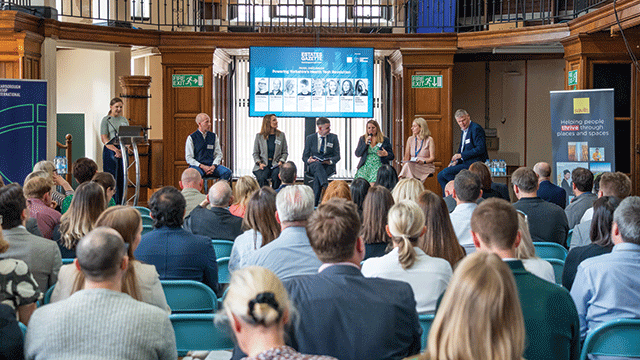Real estate forms an integral part of innovation ecosystems in which researchers, entrepreneurs and clinicians work together, supercharging innovation.
Scarborough Group International, in partnership with Savills and Estates Gazette, asked a panel of experts to join the stage at the Old Medical School in Leeds to draw parallels between the commercial success of physical assets, achieved through design and operation, and improved patient outcomes.
Deb Hetherington, who oversees innovation ecosystems for Scarborough Group, said: “Physical assets are an enabler to create and curate ecosystems. I think getting those right is essential.”
Hetherington joined Scarborough Group this year from Bruntwood SciTech to help build networks across innovation sites, including the Old Medical School. The developer plans to inject around £30m transforming the 75,000 sq ft building into a health tech innovation hub, following its acquisition from Leeds Teaching Hospitals NHS Trust in October 2024.
People make places
David Brettle, chief scientific officer at Leeds Teaching Hospitals NHS Trust, said: “I think the symbiotic relationship between the physical space and people make a real opportunity. People make a place. We bring people here, and the people bring work with other people, and together we drive forward innovation, and that means we get better outcomes for our patients.
“We had a vision for how we deliver our new hospital and the innovation and technology we’re going to need in that new hospital, but we couldn’t go from where we were so we set up an innovation pop-up, a space for those interested in health technology. It’s a catalyst to get things going. The second stage is the Old Medical School. The third stage is the innovation village.”
Maddie Julian, chief executive and co-founder at DigiBete, one of the members of the innovation pop-up, said: “If the infrastructure could be put in and it could be supercharged, then I think the sky’s the limit for what could happen.”
Last month, the trust, in partnership with Leeds City Council and West Yorkshire Combined Authority, launched the search for potential partners across investors, developers and occupiers to bring forward 1.5m sq ft of science, research, technology and innovation facilities. The project has a gross development value of £450m.
The partners have also instructed KPMG to pursue alternative delivery models outside of NHS capital budgets to bring forward new clinical buildings.
Fiona Bolam, who is responsible for Leeds City Council’s economic strategy, inclusive growth strategy, employment and skills, inward investment and the visitor economy and business support, said: “I’d really like to see us being backed by the government with the right kind of funding and structures so we can do that public-private partnership.”
Joseph Quinn, director of growth and sector development at South Yorkshire Mayoral Combined Authority, added: “We need to work with developers and investors, to help them see the opportunity in our places, including thinking about blended finance and how the public sector can de-risk other investors coming forward to support this type of activity.
“In addition, I think there is a challenge around how we get growth financing to start-ups.”
Virtuous circle
According to data from Savills, Yorkshire has become a go-to region for the healthcare sector, serving as a home to more than 670 life sciences companies – more than Oxford and Cambridge combined. The consultancy tracks more than 196,000 people employed in health and science jobs, while Yorkshire’s nine universities produce more than 15,000 science, technology, engineering and mathematics graduates each year.
Tom Mellows, who leads the UK science team at Savills, said: “The foundations are there, including academia, clinical excellence and development partners, but you have to remember it’s about the smallest companies where the early stage research and development happens and they’re very fragile.
“They need long-term commitment. They need the right early stage infrastructure. They need the right ecosystem around them. But those companies, if they’re successful, they will pull in bigger players. They will grow themselves. And it will become then a virtuous circle of continuous growth.”
Image © Josh Hall
Send feedback to Evelina Grecenko
Follow Estates Gazette












